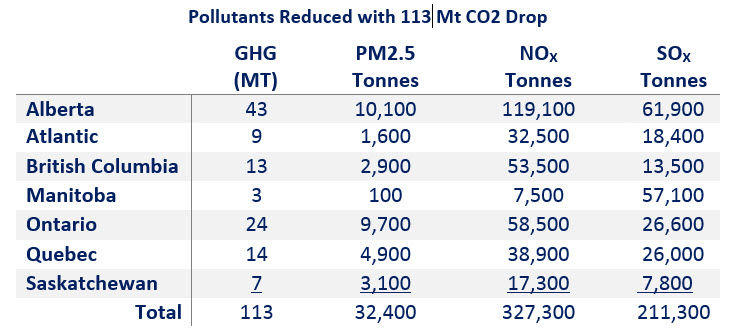The Benefits of Climate Action to Hard Working Canadian Families

A happy Earth Day to you.
It seems every dollar of analytical effort and climate lobbying is now focused on shouting “price carbon”. While our collective interrogation of carbon pricing continues to be useful, and significant progress has been made by subnationals, there are still significant headwinds. Exhibit A, yesterday’s federal #Budget2015 that once again swept climate policy away from hard working Canadian families.
So, what’s wrong? Well simply, we continue to talk about acute costs that can be minimized with carbon pricing while ignoring the diffuse benefits of climate action. We are, in fact, playing right into the hands of those unwilling to spend a Timbit per barrel to reduce their emissions.
So how do we change the messaging? Simply, we need to realign our analytics to better reveal the local and immediate benefits of climate action to Canadians.
In this post, I’ve cobbled together some very rough and preliminary estimates to indicate why we need to spend more effort on balancing out the cost ledger with benefits information.
I conclude that the air quality benefits of climate policy are likely significant. Closing Canada’s 113 Mt Copenhagen gap could generate, for hard working Canadian families, benefits in the order of $6.9 billion in 2020 alone. Clearly, this benefits stuff is worth a closer look.
So, for the wonks...
Climate action reduces co-pollutants like particulate matter and ozone forming NOX thereby avoiding health damages in our densely populated cities. Avoided carbon emissions also reduce damages in Canada like more intense and frequent storms and the premature decay of infrastructure.
Health Damages. To monetize air quality benefits, we need to link air pollutants with health outcomes.
To start, I develop a simple ratio of CO2 emissions to air pollutants by province. I use older NRTEE CIMS runs from Getting to 2050 to estimate a ratio of CO2 to PM2.4. NOx and SOx.
This ratio is then applied to a more recent GHG forecasts from the kickass wonks at Navius Research. The run identifies the likely distribution of CO2 reductions by province under a “Close the Gap” scenario, where ~$100 national carbon price could likely (perhaps maybe, if we started yesterday) deliver 113 Mt in 2020. (I know this is a Harry Potter wand waving scenario, but I am trying to be illustrative).
Combining the CO2 per pollutant ratio with the distribution of CO2 reductions by province provides a rough estimate of the reductions in air pollutants by province associated with a “Close the Gap” scenario. See table below.
Ideally, a source attribution model would assign emission reductions geography to be then coupled with an air quality model to estimate local changes in ambient air quality.

Avoided health damages are then estimated for the air quality improvements under the Close the Gap scenario. To monetize this health benefits, I use an approach based on Health Canada’s AQBAT model which translates local air quality changes into monetized health outcomes.[1] The model adopts a damage function approach that links unit changes in air emissions to changes in ambient air quality that then drives health outcomes based on known epidemiological relationships across a number of morbidity and mortality outcomes. Changes in health risks are then valued across the different health outcomes using a variety of monetization techniques.
I excavate from my hard drive simplified estimates of provincial health benefits related to PM2.5, NOX and SOx emissions. These values are presented in table below. These estimates are rough, and were estimated a number of years ago using an air quality model linked to population exposure (so they are not that bad). I then multiply these values by emissions reduced for each region.
For Carbon benefits. Environment Canada’s Social Cost of Carbon is used to estimate the GHG benefits, which is $28/tonne. The USEPA just doubled their SCC to CDN $52, so our Canadian rate is likely low. The 113 Mt have a SCC of $3.2 billion in 2020.

Conclusion. The monetized value of the reduced air pollutants and carbon benefits to Canada might be in the order of $6.9 billion in 2020. The provincial breakdown is provided below.
To put this into perspective in a very rough way, the annualized investment cost of a $100 carbon price that reduced 113 Mt in 2020 is about $670 million (assuming an average total cost of $5.7 billion, annualized at 10% over 20 years equipment using a capital recovery factor).
So, a cost benefit ratio 10.3 to 1. Which means if the estimates are off by a factor of 10, which is totally plausible, hardworking Canadian families are still better off with climate action. So, folks get to work.

[1] The AQBAT model is used in regulatory analysis to estimate the benefits of regulations that improve air quality. For example, Canada Gazette, 2014. Regulations Amending the On-Road Vehicle and Engine Emission Regulations and Other Regulations Made Under the Canadian Environmental Protection Act, 1999. Vol. 148, No. 39 — September 27, 2014, Table 9. http://www.gazette.gc.ca/rp-pr/p1/2014/2014-09-27/html/reg1-eng.php































